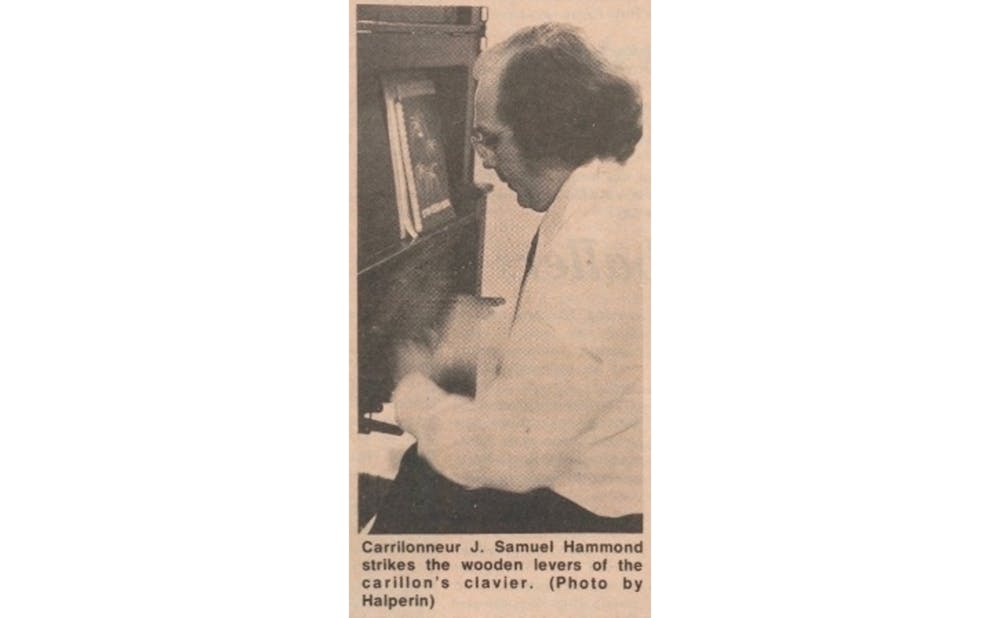It was in the gloaming at Duke University in late fall of 1966. There was a wet chill in the air, most of the trees were leafless, and a low cloud cover added to the gloom. I was trudging across West Campus from my freshman dorm to the library, overburdened with a load of books and overwhelmed by the pressures of a demanding university. My small-town school had not prepared me for the academic rigor at Duke, nor had my home life hardened me for living on a few hours of sleep a night. I was struggling, scared, worn down, and mindful that flunking out of school could result in a trip at government expense to the exotic landscape of Southeast Asia.
As I walked past the Chapel, head hanging low, out of the bell tower rang the strains of a familiar song. I stopped and listened, silently filling in the lyrics to the pealing bells' melody: “M-I-C / K-E-Y / M-O-U-S-E.” I couldn't believe my ears. It was the theme song of “The Mickey Mouse Club,” a Walt Disney television program of the 1950s that virtually everyone in my generation grew up watching. My mood lifted, my step quickened, and I hit the library with a lightness of being and a renewed sense of purpose. Although I didn't realize it at the time, that was a pivotal moment for me at Duke.
Fifty years later, almost to the month, my wife and I moved to a house on Woodburn Road in Durham. It turned out that our neighbors—Sam and Marie Hammond—were undergraduates at Duke during my time. Marie pointed out that Sam was also the University Carilloneur; that he'd been playing the carillon in Duke Chapel since he was a student.
I looked at Sam, and asked, “Were you by any chance the person who played 'The Mickey Mouse Club theme song back in 1966?”
“I was,” said Sam, with a smile and a characteristic twinkle in his eyes.
“Well,” I told him, “you may have saved my life.” And I followed with my story.
Several months later, I persuaded Sam to take me up to the carillon chamber to watch him play the instrument. My son Chip, my friend Tom and I met Sam at the elevator to the Chapel tower. Sam gave us a tour, opening doors to the magnificent vistas offered by the tower and giving us background information about the bells and the instrument.
The Duke Carillon was given in honor of James B. Duke by George G. Allen and William R. Perkins, Chair and Vice-Chair of the Duke Endowment. The bells were cast in Loughborough, England, by John Taylor Bellfounders, Ltd., a firm that traces its roots to the 14th century. The carillon comprises fifty bells that range over four chromatic octaves. The largest weighs 11,200 pounds; the smallest, 10.5 pounds.
The carillon room is a comfortable space that contains the instrument and a practice console. Sam has added personal touches to warm it up a bit. On one wall there are prints of early Christian art; family photographs appear here and there; and a framed quotation in German from Albert Einstein hangs in a conspicuous place. It reads, Was ich zu Bachs Lebenswerk zu sagen habe: hören, spielen, lieben, verehren und—das maul halten. (“What I have to say about Bach's life's work: Listen, play, love, adore and—keep your mouth shut.") It is both a reflection of Sam Hammond's love of the music of J.S. Bach and a testament to Sam's sense of humor.
We were there on a Tuesday. Sam began with a short vorschlag (ornamental prelude), and then followed by striking the foot pedal of the largest bell five times to mark the hour. After a brief pause, he followed with a short recital of Mozart dances. The bells peal loudly from Sam's perch, especially with the doors open—which is the way he likes it. But they are notably louder when one ventures outside and along the space between the chamber and the tower walls. There one can feel them. It is, as it was meant to be, a moving and a humbling experience.
Sam, who has been playing the Duke carillon since 1965, is the second person in Duke's history to be named “University Carilloneur.” And quite frankly, if you were asked to conjure up the ideal carilloneur, you couldn't do better than Sam. He is a most congenial man—shortish, bespectacled and in his seventies. His countenance could be described as “elfish,” complete with twinkling eyes and a ready giggle. But when J. Samuel Hammond takes his place on the carillon bench and begins to play, he is transformed into an altogether different human being. His facial features change and his body seems to become part of the instrument. He morphs into a rhythmical artist, hands and feet moving in a directorial ballet, commanding the bells to his purpose. It is an impressive, hypnotic scene to behold.
For my part, the experience was spiritually uplifting—as it always is when I am privileged to bask in the presence of a true artist at his work. Sam Hammond is one among many on campus whose art is readily accessible to the Duke community. I can only hope that Duke students take the occasional break from their organized busy-ness and their cell phones to absorb and reflect on the beauty that is all around them in myriad forms. My advice to them, as an alumnus fifty years removed from Duke, is to take time to smell the roses, watch the sun set, and by all means listen to Sam Hammond play the carillon.
Get The Chronicle straight to your inbox
Sign up for our weekly newsletter. Cancel at any time.

